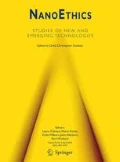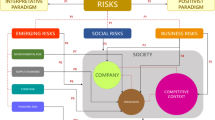Abstract
Current nanotechnology regulation is focussed on risks. On the other hand, technical guidelines and other soft law tools are increasingly replacing hard law. This risk reduction approach does not seem to be fully aligned with open principles like sustainable nanotechnology. Indeed, risk optimization tends to be rather a continuous process than a way to settle ultimate lists of risks. There is therefore a need for a more dynamic view: Life cycle assessment contributes to add momentum and context to the models. However, a complementary perspective is here suggested, based on information technologies: nanotechnology platforms. Platforms for nanotechnology governance are supposed to complement and enhance the nano-regulation, adding risk assessment and management. These platforms are mainly offering information, coordination, and context or situational awareness. More recently, some informal platforms appear to play a, certainly limited but still clear, co-regulatory role. Can these informal platforms play a relevant role in nanotechnology governance? In the context of the EU Better Regulation strategy, why not envision some of these informal platforms as future co-regulation tools? The main goal of this paper is to start a discussion on the requirements these informal co-regulatory platforms should fulfill before their hypothetical inclusion in a future better regulation toolbox.
Similar content being viewed by others
Notes
European Commission, DG Research and Innovation 2012.
Procedural Manual of the Codex Alimentarius Commission (2016) 25th ed., World Health Organization, Food and Agriculture Organization of the United Nations.
References
Ahn JJ, Kim Y, Corley EA, Scheufele DA (2016) Laboratory safety and nanotechnology workers: an analysis of current guidelines in the USA. NanoEthics 10(1):5–23
European Commission (2018) Possible amendments of Annexes to REACH for registration of nanomaterials. January 2016. Available at: http://ec.europa.eu/smart-regulation/roadmaps/docs/2014_env_013_nanomaterials_en.pdf. Accessed 13 May 2018
European Commission (2017) Impact assessment accompanying the document Commission Implementing Decision on a Delegation Agreement with the European Chemicals Agency on the European Union Observatory for Nanomaterials and the European Union Chemical Legislation Finder in the framework of the COSME programme. SWD (2017) 138 final
Ricardo Energy & Environment (2016) Support for 3rd regulatory review on nanomaterials – environmental legislation. ED 61552_Final Report, Issue Number 3
Rauscher H, Rasmussen K, Sokull-Klüttgen B (2017) Regulatory aspects of nanomaterials in the EU. Chem Ing Tech 89(3):224–231
Lai RWS, Yeung KWY, Yung MMN, Djurišić AB, Giesy JP, Leung KMY (2017) Regulation of engineered nanomaterials: current challenges, insights and future directions. Environ Sci Pollut Res 25(4):3060–3077
Bremer-Hoffmann S, Halamoda-Kenzaoui B, Borgos SE (2018) Identification of regulatory needs for nanomedicines. J Interdisciplinary Nanomedicine 3(1):4–15
Commission of the European Communities (2008) Commission recommendation of 07/02/2008 on a code of conduct for responsible nanosciences and nanotechnologies research. C(2008) 424 final
Reichow A, Dorbeck-Jung BR (2013) Discovering specific conditions for compliance with soft regulation related to work with nanomaterials. NanoEthics 7(1):83–92
Ruggiu D (2013) Temporal perspectives of the nanotechnological challenge to regulation: how human rights can contribute to the present and future of nanotechnologies. NanoEthics 7(3):201–215
van de Poel I (2016) An ethical framework for evaluating experimental technology. Sci Eng Ethics 22:667–686
Gottardo S, Pesudo LQ, Totaro S, Sintes JR, Crutzen H (2016) NANoREG harmonised terminology for environmental health and safety assessment of nanomaterials. EUR 27808. https://doi.org/10.2788/71213
OECD (2016a). Approaches on nano grouping/equivalence/read-across concepts based on physical-chemical properties (GERA-PC) for regulatory regimes. Results from the survey series on the safety of manufactured nanomaterials no. 64
OECD (2016b). Categorisation of manufactured nanomaterials. Workshop report. Series on the safety of manufactured nanomaterials no. 66
OECD (2016c). Grouping and read-across for the hazard assessment of manufactured nanomaterials. Report from the expert meeting. Series on the safety of manufactured nanomaterials no. 76
OECD (2017) Alternative testing strategies in risk assessment of manufactured nanomaterials: current state of knowledge and research needs to advance their use. Series on the safety of manufactured nanomaterials no. 80
Dorbeck-Jung B, Shelley-Egan C (2013) Meta-regulation and nanotechnologies: the challenge of responsibilisation within the European Commission’s code of conduct for responsible nanosciences and nanotechnologies research. NanoEthics 7(1):55–68
Bosso C (2016) Settling into midstream? Lessons for governance from the decade of nanotechnology. J Nanopart Res 18:163
Kurath M, Nentwich M, Fleischer T, Eisenberger I (2014) Cultures and strategies in the regulation of nanotechnology in Germany, Austria, Switzerland and the European Union. NanoEthics 8(2):121–140
Caballero-Díaz E, Simonet B, Valcárcel M (2013) The social responsibility of nanoscience and nanotechnology: an integral approach. J Nanopart Res 15:1534
Arnaldi S (2017) Changing me softly: making sense of soft regulation and compliance in the Italian nanotechnology sector. NanoEthics 11(1):3–16
Hester K, Mullins M, Murphy F, Tofail SAM (2015) Anticipatory ethics and governance (AEG): towards a future care orientation around nanotechnology. NanoEthics 9(2):123–136
Roubert F, Beuzelin-Ollivier M-G, Hofmann-Amtenbrink M, Hofmann H, Hool A (2016) “Nanostandardization” in action: implementing standardization processes in a multidisciplinary nanoparticle-based research and development project. NanoEthics 10(1):41–62
Patenaude J, Legault G-A, Beauvais J, Bernier L, Béland J-P, Boissy P, Chenel V, Daniel C-É, Genest J, Poirier M-S, Tapin D (2015) Framework for the analysis of nanotechnologies’ impacts and ethical acceptability: basis of an interdisciplinary approach to assessing novel technologies. Sci Eng Ethics 21:293–315
State Secretariat for Economic Affairs (SECO) (2012) Safety data sheet (SDS): guidelines for synthetic nanomaterials. SECO, Bern
European Commission (2011) Recommendation of 18 October 2011 on the definition of nanomaterial (2011/696/EU). Off J Eur Union L275:38–40
NanoDefine (2018) Methods for the implementation of the European definition of a nanomaterial. www.nanodefine.eu Accessed 22 May 2018
Ludlow K, Bowman DM, Gatof J, Bennett MG (2015) Regulating emerging and future technologies in the present. NanoEthics 9(2):151–163
Jahnel J (2015) Conceptual questions and challenges associated with the traditional risk assessment paradigm for nanomaterials. NanoEthics 9(3):261–276
Walker WC, Bosso CJ, Eckelman M, Isaacs JA, Pourzahedi L (2015) Integrating life cycle assessment into managing potential EHS risks of engineered nanomaterials: reviewing progress to date. J Nanopart Res 17:344. https://doi.org/10.1007/s11051-015-3151-x
Matrix Insight Ltd (2014) Request for services in the context of the FC ENTR/2008/006, lot 3: a study to support the impact assessment of relevant regulatory options for nanomaterials in the framework of REACH
Meyer DE, Upadhyayula VKK (2014) The use of life cycle tools to support decision making for sustainable nanotechnologies. Clean Techn Environ Policy 16:757–772
International Organization for Standardization (2015) 14001:2015 Environmental management systems—Requirements with guidance for use
OECD (2015) Guidance manual towards the integration of risk assessment into life cycle assessment of nano-enabled applications. Series on the safety of manufactured nanomaterials no. 57
Swiss Federal Council (FOEN) (2013) Precautionary matrix for synthetic nanomaterials. http://www.safenano.org/knowledgebase/guidance/banding/foen-2013-guidelines-on-the-precautionary-matrix-for-synthetic-nanomaterials/
Linkov I, Kurth MH, Hristozov D, Keisle JM (2015) Nanotechnology: promoting innovation through analysis and governance. Environ Syst Decis 35:2223
Bernstein MJ, Foley RW, Bennett I (2014) An operationalized post-normal science framework for assisting in the development of complex science policy solutions: the case of nanotechnology governance. J Nanopart Res 16:2492. https://doi.org/10.1007/s11051-014-2492-1
Proskuryakova L, Meissner D, Rudnik P (2017) The use of technology platforms as a policy tool to address research challenges and technology transfer. J Technol Transf 42:206–227
European Commission. European Technology Platforms. Available at: http://ec.europa.eu/research/innovation-union/index.cfm?pg=etp. Accessed 25 May 2018
Kamara I (2017) Co-regulation in EU personal data protection: the case of technical standards and the privacy by design standardisation ‘mandate’. European Journal of Law and Technology 8(1). Available at http://ejlt.org/article/view/545/723. Accessed 8 June 2018
Lynch I (2017) Compendium of projects in the European NanoSafety Cluster. 2017 Edition
European Commission (2013) NANOREG - A common European approach to the regulatory testing of nanomaterials. https://cordis.europa.eu/project/rcn/107159_en.html. Accessed 23 May 2018
European Commission (2015) PROSAFE - promoting the implementation of safe by design. https://cordis.europa.eu/project/rcn/194431_en.html Accessed 23 May 2018
Lingner S, Weckert J (2016) Nanoscale-technologies as subjects of responsible research and innovation. NanoEthics 10(2):173–176
Krabbenborg L (2016) Creating inquiry between technology developers and civil society actors: learning from experiences around nanotechnology. Sci Eng Ethics 22:902–922
Landeweerd L, Townend D, Mesman J, Van Hoyweghen I (2015) Reflections on different governance styles in regulating science: a contribution to ‘responsible research and innovation. Life Sci, Soc Policy 11:8
Finck M (2017) Digital regulation: designing a supranational legal framework for the platform economy. LSE Law, Society and Economy Working Papers 15/2017
Büscher C (2015) Risk calculation as experience and action—assessing and managing the risks and opportunities of nanomaterials. NanoEthics 9(3):277–295
Glisovic S, Pesic D, Stojiljkovic E, Golubovic T, Krstic D, Prascevic M, Jankovic Z (2017) Emerging technologies and safety concerns: a condensed review of environmental life cycle risks in the nano-world. Int J Environ Sci Technol 14:2301–2320
Malsch I, Subramanian V, Semenzin E, Zabeo A, Hristozov D, Mullins M, Murphy F, Linkov I, Marcomini A (2017) Comparing mental models of prospective users of the sustainable nanotechnology decision support system. Environ Syst Decis 37:465–483
Acknowledgments
The author would like to thank the anonymous reviewers of the article for their inspiring comments and Sandralee Lewis for the revision of the final version.
Funding
This work was supported by a Spanish Project on the Ethical and Legal Dimensions of the Web of Data and the Regulation and Rights in Current States, I + D National Research Program, Subprogram of Knowledge Generation (DER2016-78108-P), 2016-2018, awarded to Dr. Pompeu Casanovas and Dr. Antoni Roig.
Author information
Authors and Affiliations
Corresponding author
Rights and permissions
About this article
Cite this article
Roig, A. Nanotechnology Governance: from Risk Regulation to Informal Platforms. Nanoethics 12, 115–121 (2018). https://doi.org/10.1007/s11569-018-0321-1
Received:
Accepted:
Published:
Issue Date:
DOI: https://doi.org/10.1007/s11569-018-0321-1




